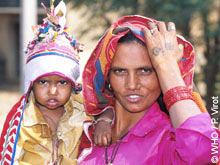 |
WOMEN AND POVERTY, in detail:
|
 |
 |
 |
 |
 |
|
|
 |
Poverty has a stronger impact on women, and vice versa, empowering women results in greater and faster progress in poverty reduction. The greater proportion of women suffering from various forms of poverty is linked to their unequal access to education, to productive resources and to control of assets, and in some cases to unequal rights in the family and in society. This in fact impacts negatively on the entire household, particularly on children, and as a consequence on the entire community.
|
|
|
In a number of countries, although women carry the bulk of the burden of farming and cattle raising or other forms of income generation, they lack property rights and cannot borrow funds, and thus never get a chance to lift themselves out of poverty. In poor families, priority is often given to providing education and vocational training to the young males, and sometimes girls go to work to support their brothers’ schooling. In some places, women and girls are given to eat the remainders of the men’s meals. In some places, restrictions in access to health care can even be fatal. Where women’s rights are recognized, poverty (including illiteracy) often prevents them from knowing their entitlements.
|
|
 In industrial countries, jobs are still often more easily given to men, pay is unequal, access to public positions more difficult, and gender roles are still discriminating. Moreover, low salaries combined with lack of affordable childcare options makes that many mothers who receive unemployment benefits are reluctant to find a job. In industrial countries, single mothers now make up a disproportionate percentage of the poor. Poverty and lesser education also make women more vulnerable to health hazards, sexually transmitted diseases (including HIV/AIDS), unwanted pregnancies and social and family abuse. Gender inequalities are not just hurting women, but the families, the communities and the countries in which they live. In industrial countries, jobs are still often more easily given to men, pay is unequal, access to public positions more difficult, and gender roles are still discriminating. Moreover, low salaries combined with lack of affordable childcare options makes that many mothers who receive unemployment benefits are reluctant to find a job. In industrial countries, single mothers now make up a disproportionate percentage of the poor. Poverty and lesser education also make women more vulnerable to health hazards, sexually transmitted diseases (including HIV/AIDS), unwanted pregnancies and social and family abuse. Gender inequalities are not just hurting women, but the families, the communities and the countries in which they live.
|
|
Effective poverty reduction policies must be rooted in the acknowledgement of women’s rights and recognize women's multiple roles and the importance of women's informal and unpaid social as well as economic work. Ensuring access of girls and women to primary and higher levels of education, medical care, reproductive health, credit, assets, as well as information on nutrition, on HIV/AIDS, on legal rights and on entitlements are all key elements of a poverty reduction strategy. They are also essential means to reduce the gender gap.
It is also important to make childcare accessible to low-income working mothers, to support women heads of households, facilitate access to public responsibilities, and to change cultural biases and social behaviours that discriminate girls and women.
|
|
|
 |
|
